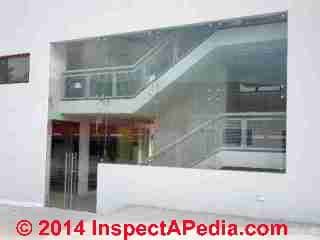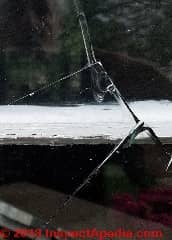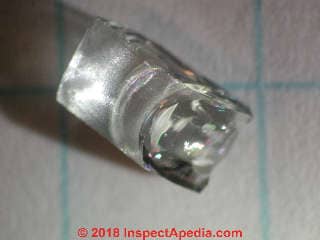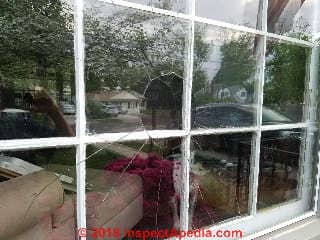 Spontaneous Window Glass Breakage
Spontaneous Window Glass Breakage
NiS Inclusions & Other Causes of Broken Tempered Glass
- POST a QUESTION or COMMENT about causes of broken window glass and other tempered glass products like oven door glass
What causes spontaneous fracture in some tempered glass windows?
This article describes the common causes of broken window glass and solar panel glass, including a list of common causes of glass panel fracture and a detailed look at spontaneous breaks in glass due to the effects of nickel sulfide (NiS) in the glass tempering process.
InspectAPedia tolerates no conflicts of interest. We have no relationship with advertisers, products, or services discussed at this website.
- Daniel Friedman, Publisher/Editor/Author - See WHO ARE WE?
Spontaneous Glass Breakage: Windows, Oven Door Glass, Glass Panels
 Causes of Spontaneous Glass Breakage.
Causes of Spontaneous Glass Breakage.
Before taking a detailed look at a spontaneous tempered glass panel fracture let's list the most-common causes of broken window glass, besides a ball tossed by my grandson Tanner Gilligan (photo shown here).
Photo: impact fracture of a large glass window. This break, unlike the plate glass window breakage described below, was not caused by heat nor insulation. But take care to diagnose window or other glass fractures accurately - the cause of a broken window is not always what it first seems.
- Impact of an object onto glass: (ball thrown by Tanner) is perhaps the most-common cause of accidental breakage of residential and other ground-level windows, occasionally higher windows too where impacts range from a softball, vandalism, or a stone kicked up by a lawnmower or weed-whacker to birds and out of control building inspection drones.
- Improper glass installation: edge-damage to glass or fixed glass panel frame by a driven nail or screw during window or glass installation.
- Other Improper glass installation, particularly in a fixed framed and with larger glass panels can cause stresses that lead to broken glass, usually showing up as a crack radiating from a point. Examples include:
Omission of rubber support pads below large heavy glass panels
Torquing of a glass panel in its frame
Point loading on glass from above, sides, or (rarely) below, such as installation of a large horizontal glass panel in a load bearing wall where the window header is omitted or inadequate - Improperly tempered glass - a factory defect, possibly inadequate composition of glass materials or improper heat or tempering procedures
- Improperly-constructed glass panel - double or triple pane glass whose rim or separators were not properly sized or installed or sealed
- NiS or Nickel Sulfide inclusions in the glass as an ingredient in the manufacture of tempered glass. Below we explain in detail and cite research describing how NiS inclusions can cause spontaneous glass fractures.
Watch out: take care when diagnosing a suspected case of spontaneous glass fracture because similar glass fracture patterns ("butterfly failures") that produce multiple small glass fragments and cracks radiating through the panel can be caused by impact OR by NiS inclusions.
Reader Reports Broken Windows After Adding Foam Insulation:
Watch out: while the facts and details of this report are incomplete. Reader Joe reported in 2018, adding insulation in the form of solid foam against the interior of a thick plate glass window in an un-heated home might result in a broken window. He was probably quite correct, but it's likely that additional factors were involved.
We were not able to obtain a photo of the 1/4" plate glass window break described by Joe, below. Our photos illustrate the type of glass fracture that can occur when glass is struck by an object, in this case a lacrosse ball.
[Click to enlarge any image]
(May 7, 2018) Joe said: plate glass overheated & broke due to the insulating space on one side of the glass and the foam board on the other.
Don't insulate glass with foam board. Two of my very large plate windows are now shattered.
My 1958 home is only used seasonally, during the summer months. It is shut down completely for the winter with zero heat or humidity control. The home has a basement, reasonably dry.
All of my previous years' shutdown efforts have worked perfectly including plumbing protection. The single area of concern has been with these windows. They are 1/4" plate glass, single pane with an exterior storm window. Air space between is 5 inches. My plate windows are 8 ft wide x 5 ft high.
The issue has been with condensation and the reason for finding this web page. In the springtime, when opening the home back up, I've found the window sills (stained pine), to be deteriorating from water exposure. In the kitchen, there is always evidence of it having run off the sill, down the wall and staining the flooring.
So, common sense told me that if I could stop the condensation, all should be good. By the way, there is never enough moisture present to cause other issues, such as mold, mildew or even the slightest of mildew odors. So, I cut and fit 1/2 inch pink foam board to fit against the plate glass, holding it in place with a few drywall screws.
I then closed up the home and left for the winter. At some point in the next 6 months, the windows cracked with no piece bigger than 2 x 2 ft. It all stayed in place - just cracks going everywhere.
My analysis - the plate glass became overheated due to the insulating space on one side of the glass and the foam board on the other. The glass was likely forced to expand past the point it ever has in the last 60 years. The extensive cracking gives me the impression it was one big pop from stress at all sides. It likely happened soon after shutting down the home last October as that would have been the warmest of the last 6 months.
The storm windows, despite being a thinner glass, held up fine.
This was probably due to it's ability to dissipate the heat to the outside, unimpeded. Cost to replace will be about $400 per window if using the same product. Although a thermal window replacement would be wise, cost may prevent that.
Additional notes:
(1) Had there been no storm window, the foam may have been just fine to use.....but I wouldn't risk it again.
(2) I have a 3rd plate window that did not break. I believe it's because the seam between the two sheets opened up a couple inches, likely venting away some of the heat. I hope this information is helpful to others.
By the way - I did this prior to reading this web page, so my actions were not based on anything I read here.
This discussion was posted originally
(May 7, 2018) (mod) said: diagnosing a specific case of spontaneous glass breakage
 Thank you for the helpful details about insulation and its apparent explanation of cracked, broken window plate glass.
Thank you for the helpful details about insulation and its apparent explanation of cracked, broken window plate glass.
Heavy 1/4" thick plate glass, being quite thick, could certainly crack and shatter in response to temperature variation, but the timing of just when that happens may also be due to internal stresses in the glass associated with nickel hydride or NiS as explained in some of our research citations below.
Photo: a fragment of tempered oven door glass retrieved by the moderator (DF) following a shattering explosion of glass from a Jenn-Air oven door.
See details at OVEN DOOR REPAIR / REPLACE, Jenn-Air
I think that for your glass breakage case we need a few more details to have a confident diagnosis beyond the effect of adding insulation to the glass, because plenty of other similarly insulated windows have not broken.
Am I correct that your foam insulation was put up against the glass from the interior of the building?
That why does invited a heat accumulation in the window that was previously cold by air inside the building.
Also is there any possibility that the screws that you used to hold the insulation in place passed close to the edges of the glass and added stress points? A clue would be cracks that had a point of origin near those screws.
What color was the insulating foam? We have seen, for example, warping of main entry doors behind the storm door after the occupants painted the entry door a darker color than before.
Is there a possibility that decay from prior condensation and leaks cause a shift in the window frame that's stressed the glass?
If so that stress, combined with even a small change in temperature behavior from the insulation, could have push the glass over the edge into fracture.
In sum I think we are looking for either a point of mechanical stress to the glass or its frame, or an accumulation of heat in an area that stressed one side of the glass.
Don't Rely on Window Insulation to Solve Indoor Moisture or Condensation Problems
Watch out: if your home is suffering interior condensation - the original reason you tried insulating your windows - adding window insulation is not likely to fix that problem.
Condensation occurs on indoor surfaces or inside walls or ceilings or other building cavities when those spaces reach the dew point AND when there is a source of excessive indoor moisture or humidity.
Start by finding and fixing sources of high indoor humidity.
That might begin by looking for building leaks or evidence of water entry. For example a damp crawl space could be the root cause of the problem you were trying to address in the first place.
See CRAWL SPACE DRYOUT - home
Also review passive building ventilation such as proper attic ventilation design.
See ROOF VENTILATION SPECIFICATIONS - home
Joe said: foam insulation on glass interior, heat accumulation.
Answer - Yes, the foam insulation was placed against glass on interior-side of home. Yes, it did invite heat accumulation.
Answer - No, the screws made zero contact with the glass. They were installed in a similar manner to how brads are used to hold pictures into frames, so in this case, the screws were 1/2" away from the glass (the thickness of the foam).
Answer - The foam is the pink-colored, Owens-Corning, "Foamular," in 1/2" thickness. The color could be described as medium in shade.
Answer - No, although the window sill finish has deteriorated from the prior condensation, it is superficial and not a factor. The other 3 sides of the window frame materials show zero moisture exposure.
Answer -
1. Historical baseline: Again, bear in mind that these windows have undergone 60 years of annual temperature swings successfully.
2. What, if anything changed from prior years? Simply, the addition of insulating foam panels.
3. Breakage pattern of both windows is reasonably identical and consistent with thermal stress, not mechanical stress or impact stress.
4. While the windows have annually seen thermal stresses, I'm confident that the foam did indeed push it too far thermally.
Again, I'm providing this information for anyone considering the addition of foam panels or other insulation to a window surface. While your results may be different, I do not recommend it.
(Mod) Said: Research on Mechanisms of Glass Window Failures: Fire, Radiant Heat, Spontaneous Glass Breakage
 Thanks Joe those details are helpful.
Thanks Joe those details are helpful.
My photo: Tanner Daniel Gilligan's ball toss produced a characteristic round hole and radiating cracks in a large single-pane storm window of this New Jersey home. Needless to add, his mom had further advice for Tanner about this accident.
If you had photos that'd be even better.
The medium shade pink insulation against the glass may indeed have kept the indoors cooler while at the same time reflecting heat into the glass itself - as it blocked indoor air from circulating (by convection) against the glass surface.
Depending on the weather and indoor vs outdoor temperatures, we probably saw a significant temperature difference on the exterior vs interior surface of that heavy plate glass.
... under moderate heating, glass just cracks but did not fall out. (Harada 2000) cited below.
More extreme examples of temperature stressed glass breakage are reported in the event of building fires.
Spontaneous (and not) Glass Failure Cause Research
- GTS, "Unexplained Glass Failure - Don't Jump to inclusion conclusions" [web article], Glass Technology Services Ltd., 9 Churchill Way, Chapeltown, Sheffield, South Yorkshire S35 2PY United Kingdom, Tel: +44 (0) 114 290 1801, Email: enquiries@glass-ts.com Website: https://www.glass-ts.com/
Retrieved 2019/03/08, original source: https://www.glass-ts.com/news/unexplained-glass-failure-don-t-jump-to-inclusion-conclusions - Harada, Kazunori, Atsushi Enomoto, Kazuki Uede, and Takao Wakamatsu. "An experimental study on glass cracking and fallout by radiant heat exposure." Fire Safety Science 6 (2000): 1063-1074.
Abstract:
To develop a simple model to predict the glass cracking and/or breaking, radiant heating tests were carried out on float glass and wired glass. By changing the imposed heat flux and lateral restraint of the glass, 50 experiments were carried out to measure the time to initial crack and fallout.
Temperatures were measured at the center of glass pane and edge, while the strain was measured at the edge. From the experimental data, the critical heat flux was determined under which no glass cracking takes place.
By using the measured temperature and stress, the ultimate tensile stress of the glass edge was calculated.
The obtained values were lower than the literature values for plain glass surface where no effect of micro defects at the cutting edge is taken into account. By analyzing the post crack behavior, it was pointed out that the fallout area mainly depends on imposed heat flux and slightly on restraint.
Under intense heating (more than 9kw/m2), large piece of glass tends to fall out, however under moderate heating, glass just cracks but did not fall out. Therefore it was pointed out that the application of the thermal stress model for glass breaking is limited to intensely heated scenarios. A simple prediction formula was derived for such scenarios. - Jacob, Leon. A REVIEW OF THE NICKEL SULPHIDE INDUCED FRACTURE IN TEMPERED GLASS [PDF] Glass Performance Days (2001). Glass Processing Days, 18–21 June 2001 pp. 108-110,
www.glassfiles.com retrievbed 20198/03/08 original source: http://www.aisglass.com/sites/default/files/pdfs/technical%20papers/AIS-13.pdf
A discussion of spontaneous window glass breakage caused by to nickel sulfide (NiuS) inclusions contaminants in toughened glass. - spontaneous fracture of tempered glass.
Abstract: A brief review of the magnitude of the nickel sulphide problem is discussed. The need for heat soaking of all tempered glass is questioned given that the total volume of NiS inclusions in glass is extremely low and so not warranted given the cost.
A new technique for the prediction of the fracture rate of NiS induced failures is offered for discussion. - Kasper, Andreas, && Oussama Yousfi, SPONTANEOUS GLASS BREAKAGE CAUSED by NICKEL SULFIDE (a review) [PDF] in Glass Performance Days (2009) pp. 600-602, www.gpd.fi
Abstract Excerpts:
During the glass melting process, and during the tempering process, the high temperature modification (alpha-NiS) forms, stable ab ove 390 °C. It does not transform during the process because of too high cooling speeds: it is frozen.
The volume of the beta-NiS is by ab out 4% higher than that of alpha-NiS. The alpha to beta transformation puts an internal spot-wise stress on the glass.
Pressure causes the initiation of small semicircular flaws around the inclusion. These are stable until a certain diameter has been reached, depending on the inclusion's environbmental stress situation inside the glass.
At room temperature, the alpha to beta transformation is slow. It takes months to years. A spontaneous break is happening when the inclusion's growth oversteps a critial limit.
An incubation period is typical for NiS breakage. The retardation may range from a few months to a couple of years. It is caused by different thermal dialation coefficients of glass and NiS.
Heat soaking following European standard EN14179-1, prescribes the toughened glass to be heated up to (290 +/- 10)°C, and this temperature to be kept constant during at least two hours. Following research done in the past, this theoretically reduces the breakage probability to below 10-6, ie.e. less than one break on 400 t of glass per year. ... - Keski‐Rahkonen, Olavi. "Breaking of window glass close to fire." Fire and materials 12, no. 2 (1988): 61-69.
- Taira, Shuji, Ryuichi Ohtani, and Takayuki Kitamura. "Application of J-integral to high-temperature crack propagation: part I—creep crack propagation." Journal of Engineering Materials and Technology 101, no. 2 (1979): 154-161.
Joe said: research? Hooey!
I'm not sure how helpful all your "research" is to the average person considering application of foam-to-glass. My posting is detailed, concise and to the point.
It contains no fluffy diagnosis and research and the failure mechanism is far from rocket science.
The point being, this particular InspectApedia subject: WINDOW INSULATION OPTIONS - how to install permanent or removable insulating panels or shades for windows: stop un-wanted heat loss or heat gain has now been shown to exhibit an obvious downside under specific conditions.
My posting is a simple, cautionary note, to be heeded or not as the reader may choose. Why a photo? We all know what cracked glass looks like.
(mod) said: research & details about glass breakage can be diagnostic & may prevent future glass catastrophes
Thank you for your comments and opinion, Joe.
From your report there seems to be little doubt that some windows blocked by insulation, particularly very thick plate glass in an un-heated building exposed to great variations in outdoor temperature (and perhaps humidity, and freezing) can break windows.
The case you report is so rare, and the use of window insulation, including use of solid foam, is so widespread, that we seek further details to help others prevent the same damage.
However if you take a look at what glass experts say about "spontaneous glass breakage" you may notice that some very careful and illuminating work that has been done that is quite helpful in explaining why someone might have fixed tempered glass windows installed for years, with or without added thermal stress from DIY insulation, followed by a sudden fracture.
I have, for example, seen windows that were broken by birds flying into them after a foil-faced reflective insulation was inserted against the window interior. With nobody on site at the time of the window break, we want to be as sure as possible that we have named the correct cause of the broken glass.
It is indeed unfortunate to live in a post truth era where the importance of actually understanding the science or the mechanism of what happens to us feels irrelevant to some.
What is more interesting might be enough understanding of when and how insulation might cause glass to break that people don't repeat the error that you described.
Simply saying "don't put insulation near your glass" is likely to run afoul of the problem that there are many window glass insulating systems on the market that work perfectly well.
It's best not to throw the baby out with bathwater by making too general a remark.
Polite debate is always welcomed here.
A photo of exactly where and how your 1/4" thick plate glass window cracked could be diagnostic.
Glass does not always break or crack in an identical pattern at all. A point of impact break (stone thrown by mower, screw putting pressure on the edge of glass) will produce radiating fractures that are very different from a lacrosse ball that is tossed against a glass window by my grandson Tanner D.G. as illustrated in our broken window glass photos just above.
...
Continue reading at WINDOW INSULATION OPTIONS or select a topic from the closely-related articles below, or see the complete ARTICLE INDEX.
Or see these
Recommended Articles
- GLASS vs HEAT MIRROR SOLAR GAIN/Loss
- GREENHOUSE DESIGN for SOLAR HEATING
- GREENHOUSE / SUNSPACE GLARE
- LOW-E VS QUAD-GLAZING
- SOLAR COLLECTOR FILMS - up to date information about the performance of films to increase solar collector efficiency
- SPONTANEOUS GLASS BREAKAGE NiS
- STORM WINDOW GUIDE - home
- WINDOWS & DOORS - home
Suggested citation for this web page
SPONTANEOUS GLASS BREAKAGE NiS at InspectApedia.com - online encyclopedia of building & environmental inspection, testing, diagnosis, repair, & problem prevention advice.
Or see this
INDEX to RELATED ARTICLES: ARTICLE INDEX to DOORS & WINDOWS
Or use the SEARCH BOX found below to Ask a Question or Search InspectApedia
Or see
INDEX to RELATED ARTICLES: ARTICLE INDEX to BUILDING INSULATION
Or use the SEARCH BOX found below to Ask a Question or Search InspectApedia
Ask a Question or Search InspectApedia
Try the search box just below, or if you prefer, post a question or comment in the Comments box below and we will respond promptly.
Search the InspectApedia website
Note: appearance of your Comment below may be delayed: if your comment contains an image, photograph, web link, or text that looks to the software as if it might be a web link, your posting will appear after it has been approved by a moderator. Apologies for the delay.
Only one image can be added per comment but you can post as many comments, and therefore images, as you like.
You will not receive a notification when a response to your question has been posted.
Please bookmark this page to make it easy for you to check back for our response.
IF above you see "Comment Form is loading comments..." then COMMENT BOX - countable.ca / bawkbox.com IS NOT WORKING.
In any case you are welcome to send an email directly to us at InspectApedia.com at editor@inspectApedia.com
We'll reply to you directly. Please help us help you by noting, in your email, the URL of the InspectApedia page where you wanted to comment.
Citations & References
In addition to any citations in the article above, a full list is available on request.
- In addition to citations & references found in this article, see the research citations given at the end of the related articles found at our suggested
CONTINUE READING or RECOMMENDED ARTICLES.
- Carson, Dunlop & Associates Ltd., 120 Carlton Street Suite 407, Toronto ON M5A 4K2. Tel: (416) 964-9415 1-800-268-7070 Email: info@carsondunlop.com. Alan Carson is a past president of ASHI, the American Society of Home Inspectors.
Thanks to Alan Carson and Bob Dunlop, for permission for InspectAPedia to use text excerpts from The HOME REFERENCE BOOK - the Encyclopedia of Homes and to use illustrations from The ILLUSTRATED HOME .
Carson Dunlop Associates provides extensive home inspection education and report writing material. In gratitude we provide links to tsome Carson Dunlop Associates products and services.

